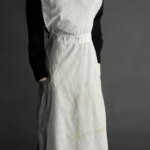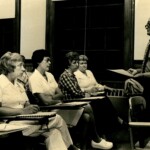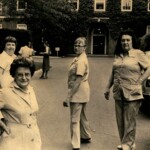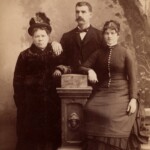
Maids had style beyond their uniforms. In this photo from 1886 are two launderers and a maid, all staff members from Dewey House. They would not have dressed in these clothes for their jobs, but on their days off they traded their uniforms for the elegant styles of the time.
Smith College Archives
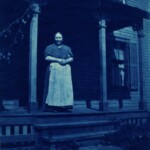
Housekeepers are not the only people who keep Smith houses running. This laundress from the 1890s would have washed the houses' linens. This included bedding, tablecloths, and in some years the maids' uniforms. Note how well-worn her apron is.
Smith College Archives

In 1912, house mothers introduced a uniform for the maids for the first time. This photo of two Morris House maids from 1919 shows a uniform of all-white, with an optional apron. A note with the photo reads: "The Morris House maids were Nora Danahy and 'Margaret.' Nora was my friend in times of stress. If I missed breakfast she never failed to come blustering along the hall complaining of those who overslept, but with her hands behind her back, holding a cup of coffee and whatever thing she could get from the kitchen." Some students formed close friendships with the maids who lived in their houses.
Smith College Archives

The earliest housekeepers were the heads of houses, also known as house mothers. This woman was the housekeeper of the now nonexistent Dickinson House from 1922-1928. House mothers were well-educated, upper-middle class women. They managed the houses’ staff and educated students on everything from finance to courtship. They dressed fashionably because part of their job was to instruct students on how to dress well.
Smith College Archives.

A maid's apron from 1895-1905. Maids were often the faces of a home, because they opened the door to greet visitors. They had to look presentable, while also wearing clothes that could get dirty while cleaning. This made aprons an essential part of a maid’s wardrobe. An apron could be removed to reveal a clean dress underneath.
Smith College Historic Clothing Collection
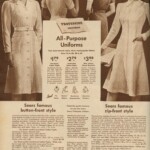
Maids’ uniforms were often the same as or similar to uniforms worn by waitresses and nurses. All three of these professions involve lots of cleaning, moving around, and interacting with the public or with guests. Uniforms had to be presentable, flexible, and easy to clean.
Sears Catalogue Spring and Summer 1942, Smith College Historic Clothing Collection
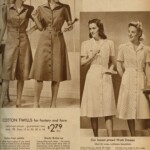
In years when the college did not provide uniforms, maids could buy them from a catalogue like this one. House mothers outlined the types of uniforms maids should order. In 1942, they had different uniforms for different times of day. They were required to wear a simple cotton dress for breakfast, a white or colored uniform for lunch, and a white uniform with short sleeves, like the ones pictured, for dinner.
Sears Catalogue Spring and Summer 1943, Smith College Historic Clothing Collection
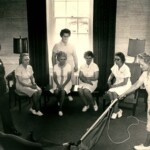
Housekeepers attending training in 1973. In this photo from 1973, each housekeeper’s uniform is slightly different. These housekeepers bought their uniforms individually, not through the college’s supplier. They all conform to the same requirements first outlined in 1942: a short white dress with short sleeves. They also all wear sensible white shoes.
Smith College Archives

There was a large amount of overlap between housekeeping and dining jobs until the two were formally separated and standardized in 1972. Many housekeepers worked under two supervisors; one in housekeeping and one in dining. Their uniforms were similar, and sometimes exactly the same for both jobs. This cook in a photo from around 1972 looks like she would be at home in any of the housekeepers’ photos from the same period.
Smith College Archives

Housekeepers attend training in 1972. Their name tags are clearly visible, an essential part of their uniform.
Smith College Archives
